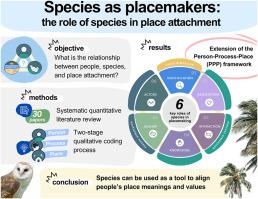物种作为场所制造者:物种在场所依恋中的作用
IF 5.4
2区 地球科学
Q1 GEOGRAPHY
引用次数: 0
摘要
我们与地方的联系是建立在由塑造我们自己身份的意义和价值观定义的纽带路线的基础上的。在全球环境变化的背景下,一个地方的特定特征的意义和作用——比如生活在那里的物种——正在改变和重新定义人与地的关系。在此,我们对人类、物种和地方依恋之间的相互作用进行了系统的综述。我们的综述确定了30项同行评议的研究,这表明这是一个新兴的研究领域。根据我们的研究结果,我们阐述了物种与地点依恋之间的关系,并强调了其与地点依恋多维结构的联系。基于人-过程-地点框架,我们描述了物种在文献中明显的地点依恋中扮演的六个角色:1)识别,2)关联,3)互动,4)知识,5)亲属关系和6)行动者。鉴于环境变化的可预见影响,我们呼吁地方依恋学者考虑物种在人地关系中的角色变化。通过将物种作为保护策略的焦点,所描述的六个角色建立在现有框架的基础上,并强调了在管理实践中形成有意行为的重要过程。本文章由计算机程序翻译,如有差异,请以英文原文为准。

Species as placemakers: the role of species in place attachment
Our connections to places are formed on the basis of bonding routes defined by the meanings and values that shape our own identity. In the context of global environmental change, the meanings and role of specific features of a place - such as the species living there - are shifting and redefining people-place relationships. Here we conduct a systematic review to explore the current literature on the interplay between people, species, and place attachment. Our review identified 30 peer-reviewed studies which suggests this is an emergent area of research. Drawing from our findings, we illustrate the relationship explored between species and place attachment and highlight its connection to the multidimensional construct of place attachment. Based on the person-process-place framework, we describe six roles that species played in place attachment evident in the literature: 1) identification, 2) association, 3) interaction, 4) knowledge, 5) kinship, and 6) actors. With foreseeable impacts of environmental change, we call for place attachment scholars to consider the changing role of species in people-place relationships. By using species as a focal point in conservation strategies, the six roles described builds on existing frameworks and highlights important processes in shaping intentional behaviours in management practices.
求助全文
通过发布文献求助,成功后即可免费获取论文全文。
去求助
来源期刊

Applied Geography
GEOGRAPHY-
CiteScore
8.00
自引率
2.00%
发文量
134
期刊介绍:
Applied Geography is a journal devoted to the publication of research which utilizes geographic approaches (human, physical, nature-society and GIScience) to resolve human problems that have a spatial dimension. These problems may be related to the assessment, management and allocation of the world physical and/or human resources. The underlying rationale of the journal is that only through a clear understanding of the relevant societal, physical, and coupled natural-humans systems can we resolve such problems. Papers are invited on any theme involving the application of geographical theory and methodology in the resolution of human problems.
 求助内容:
求助内容: 应助结果提醒方式:
应助结果提醒方式:


